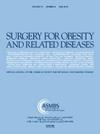Weight loss and health status 10 years after laparoscopic adjustable gastric band insertion in adolescents: a follow-up report from Teen-LABS
IF 3.5
3区 医学
Q1 SURGERY
引用次数: 0
Abstract
Background
Metabolic and bariatric surgery is a safe and effective treatment strategy for severe childhood obesity, affecting 10% of US adolescents.
Objectives
This prospective observational study addresses knowledge gaps related to changes in weight, cardiometabolic risk, and weight-related quality of life (WRQOL) in adolescents 10 years after laparoscopic adjustable gastric band (LAGB) insertion.
Setting
Five Teen-Longitudinal Assessment of Bariatric Surgery (Teen-LABS) US centers.
Methods
Anthropometric, micronutrient, cardiometabolic risk, and WRQOL data were collected on 274 adolescents undergoing metabolic and bariatric surgery, of which 14 participants underwent LAGB insertion (2008–2011). Descriptive analyses compared outcomes from baseline to 10 years.
Results
Participants were mostly female (86%), White (71%), with a median age of 18.5 years and preoperative median BMI of 49. Baseline prevalence of type 2 diabetes, hypertension, and dyslipidemia were 1 of 14 (7%), 8 of 14 (57%), and 8 of 13 (62%), respectively, versus 10-year prevalence of 1 of 8 (13%), 4 of 10 (40%), and 3 of 9 (33%), respectively. Two participants underwent LAGB removal (years 2 and 3), whereas two converted from LAGB to Roux-en-Y gastric bypass (years 2 and 6). Following initial BMI reduction (−10%) at year 1, 10-year median BMI in the LAGB retention group was 51, representing a 9.2% increase versus baseline. Micronutrient abnormalities and WRQOL remained similar between baseline and 10 years. One participant (1 of 14) withdrew from the study at year 7.
Conclusions
Long-term follow-up of this cohort reveals that LAGB had minimal impact on BMI, cardiometabolic risk factors, and WRQOL among adolescents. These results confirm the limited efficacy of LAGB in the pediatric population.
青少年腹腔镜可调节胃束带置入术后 10 年的体重减轻和健康状况:Teen-LABS 的随访报告。
背景:代谢和减肥手术是治疗严重儿童肥胖症的一种安全有效的方法,美国有10%的青少年患有肥胖症:这项前瞻性观察研究填补了有关青少年在腹腔镜可调节胃束带(LAGB)植入 10 年后体重变化、心脏代谢风险和体重相关生活质量(WRQOL)方面的知识空白:环境:美国五个青少年减肥手术纵向评估中心(Teen-LABS):收集了274名接受代谢和减肥手术的青少年的人体测量、微量营养素、心脏代谢风险和WRQOL数据,其中14名参与者接受了LAGB植入手术(2008-2011年)。描述性分析比较了从基线到10年的结果:参与者大多为女性(86%)、白人(71%),年龄中位数为 18.5 岁,术前体重指数中位数为 49。2型糖尿病、高血压和血脂异常的基线患病率分别为14人中1人(7%)、14人中8人(57%)和13人中8人(62%),而10年患病率分别为8人中1人(13%)、10人中4人(40%)和9人中3人(33%)。两名参与者接受了 LAGB 切除术(第 2 年和第 3 年),两名参与者从 LAGB 转为 Roux-en-Y 胃旁路术(第 2 年和第 6 年)。LAGB 保留组的 BMI 在第 1 年首次下降(-10%)后,10 年的中位数为 51,与基线相比增加了 9.2%。微量营养素异常和 WRQOL 在基线和 10 年间保持相似。一名参与者(14 人中的 1 人)在第 7 年退出了研究:对该队列的长期随访显示,LAGB 对青少年的体重指数、心脏代谢风险因素和 WRQOL 的影响微乎其微。这些结果证实了 LAGB 在儿科人群中的疗效有限。
本文章由计算机程序翻译,如有差异,请以英文原文为准。
求助全文
约1分钟内获得全文
求助全文
来源期刊
CiteScore
6.70
自引率
12.90%
发文量
570
审稿时长
56 days
期刊介绍:
Surgery for Obesity and Related Diseases (SOARD), The Official Journal of the American Society for Metabolic and Bariatric Surgery (ASMBS) and the Brazilian Society for Bariatric Surgery, is an international journal devoted to the publication of peer-reviewed manuscripts of the highest quality with objective data regarding techniques for the treatment of severe obesity. Articles document the effects of surgically induced weight loss on obesity physiological, psychiatric and social co-morbidities.

 求助内容:
求助内容: 应助结果提醒方式:
应助结果提醒方式:


